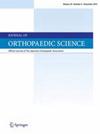Magnetic resonance imaging findings in patients with dropped head syndrome
IF 1.5
4区 医学
Q3 ORTHOPEDICS
引用次数: 0
Abstract
Background
Dropped head syndrome (DHS) is difficult to diagnose only by clinical examination. Although characteristic images on X-rays of DHS have been studied, changes in soft tissue of the disease have remained largely unknown. Magnetic resonance imaging (MRI) is useful for evaluating soft tissue, and we therefore performed this study with the purpose of investigating the characteristic signal changes of DHS on MRI by a comparison with those of cervical spondylosis.
Methods
The study involved 35 patients diagnosed with DHS within 6 months after the onset and 32 patients with cervical spondylosis as control. The signal changes in cervical extensor muscles, interspinous tissue, anterior longitudinal ligament (ALL) and Modic change on MRI were analyzed.
Results
Signal changes of cervical extensor muscles were 51.4% in DHS and 6.3% in the control group, those of interspinous tissue were 85.7% and 18.8%, and those of ALL were 80.0% and 21.9%, respectively, suggesting that the frequency of signal changes of cervical extensor muscles, interspinous tissue and ALL was significantly higher in the DHS group (p < 0.05). The presence of Modic change of acute phase (Modic type I) was also significantly higher in the DHS group than in the control group (p < 0.001).
Conclusion
MRI findings of DHS within 6 months after the onset presented the characteristic signal changes in cervical extensor muscles, interspinous tissue, ALL and Modic change. Evaluation of MRI signal changes is useful for an objective evaluation of DHS.
掉头综合征患者的磁共振成像结果。
背景:低头综合征(DHS)很难仅通过临床检查来诊断。虽然已经对 DHS 的 X 射线特征图像进行了研究,但该病的软组织变化在很大程度上仍不为人所知。磁共振成像(MRI)可用于评估软组织,因此我们进行了这项研究,目的是通过与颈椎病的磁共振成像进行比较,研究 DHS 在磁共振成像上的特征性信号变化:研究对象包括 35 名在发病后 6 个月内确诊的 DHS 患者和 32 名对照组颈椎病患者。分析了核磁共振成像中颈伸肌、棘间组织、前纵韧带(ALL)的信号变化以及 Modic 变化:结果:颈伸肌信号变化在 DHS 组为 51.4%,对照组为 6.3%;棘间组织信号变化在 DHS 组为 85.7%,对照组为 18.8%;ALL 信号变化在 DHS 组为 80.0%,对照组为 21.9%:发病后 6 个月内的 DHS MRI 检查结果显示,颈伸肌、棘间组织、ALL 和 Modic 信号变化具有特征性。磁共振成像信号变化的评估有助于对 DHS 进行客观评估。
本文章由计算机程序翻译,如有差异,请以英文原文为准。
求助全文
约1分钟内获得全文
求助全文
来源期刊

Journal of Orthopaedic Science
医学-整形外科
CiteScore
3.00
自引率
0.00%
发文量
290
审稿时长
90 days
期刊介绍:
The Journal of Orthopaedic Science is the official peer-reviewed journal of the Japanese Orthopaedic Association. The journal publishes the latest researches and topical debates in all fields of clinical and experimental orthopaedics, including musculoskeletal medicine, sports medicine, locomotive syndrome, trauma, paediatrics, oncology and biomaterials, as well as basic researches.
 求助内容:
求助内容: 应助结果提醒方式:
应助结果提醒方式:


